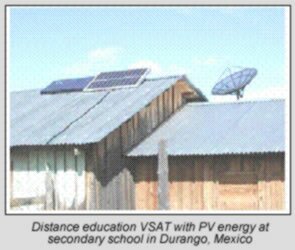VSAT
Home > THE BASICS> ICT Options > Wireless Voice & Data Equipment > VSAT
A very small aperture terminal (VSAT) is a small satellite earth station with an antenna used for transmitting and/or receiving signals from a satellite. VSAT antennas generally range from 0.45 m to 1.8 m in diameter, and support a variety of applications in rural and remote areas, including:
A typical VSAT unit can draw around 60 W. Low-power VSAT models for rural telephony are available which consume about 30 W on average - less than 40 W in operation, 15 W while idle, and as little as 5 W in standby with power management software. Many conventional satellite receivers only accept AC, but there are models designed specifically for use in rural areas that accept DC input. Manufacturers suggest that certain VSAT models should not be disconnected so as to eliminate the need to reprogram or recalibrate them. While not all VSAT models have this requirement, those that do may consume a significant amount of energy even when the service is not being used. While unfortunate, there is little way to avoid this problem since VSAT stations for different satellite systems and services are generally not interoperable. |
